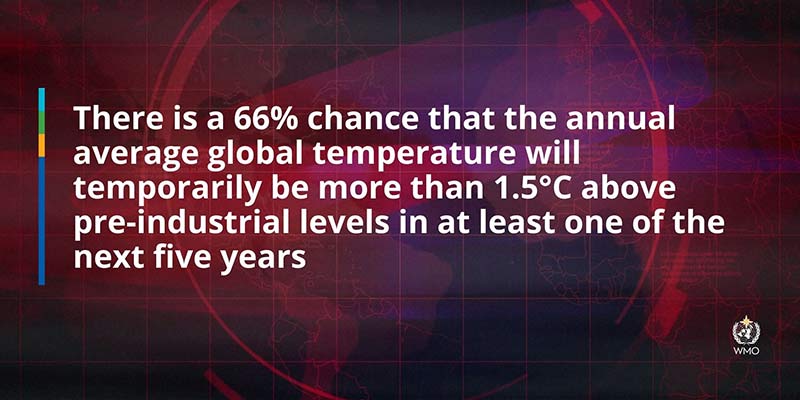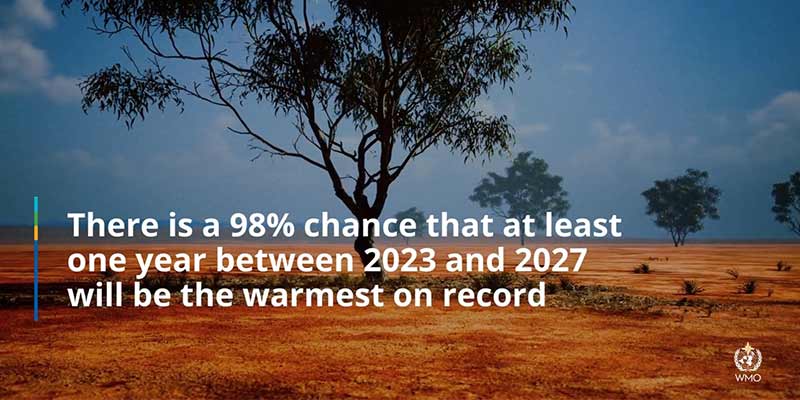- World
- May 18
Next five years set to be hottest period ever, warns WMO
Global temperatures are likely to surge to record levels in the next five years, fuelled by heat-trapping greenhouse gases and a naturally occurring El Nino event, according to a new update issued by the World Meteorological Organisation (WMO).
The new report was released ahead of the World Meteorological Congress, which will discuss how to strengthen weather and climate services to support climate change adaptation. Priorities for discussion at Congress include the ongoing Early Warnings for All initiative to protect people from increasingly extreme weather and a new Greenhouse Gas Monitoring Infrastructure to inform climate mitigation.
Key points:
• There is a 66 per cent likelihood that the annual average near-surface global temperature between 2023 and 2027 will be more than 1.5°C above pre-industrial levels for at least one year.
• There is a 98 per cent likelihood that at least one of the next five years, and the five-year period as a whole, will be the warmest on record.
• The report does not mean that we will permanently exceed the 1.5°C level specified in the Paris Agreement which refers to long-term warming over many years. However, WMO is sounding the alarm that we will breach the 1.5°C level on a temporary basis with increasing frequency.
• A warming El Nino is expected to develop in the coming months and this will combine with human-induced climate change to push global temperatures into uncharted territory. This will have far-reaching repercussions for health, food security, water management and the environment.
• The average global temperature in 2022 was about 1.15°C above the 1850-1900 average.
• The annual mean global near-surface temperature for each year between 2023 and 2027 is predicted to be between 1.1°C and 1.8°C higher than the 1850-1900 average. This is used as a baseline because it was before the emission of greenhouse gases from human and industrial activities.
• Global mean temperatures are predicted to continue increasing, moving us away further and further away from the climate we are used to.
• Arctic warming is disproportionately high. Compared to the 1991-2020 average, the temperature anomaly is predicted to be more than three times as large as the global mean anomaly when averaged over the next five northern hemisphere extended winters.
• Predicted precipitation patterns for the May to September 2023-2027 average, compared to the 1991-2020 average, suggest increased rainfall in the Sahel, northern Europe, Alaska and northern Siberia, and reduced rainfall for this season over the Amazon and parts of Australia.
A warming El Nino
• The cooling influence of La Nina conditions over much of the past three years temporarily reined in the longer-term warming trend. But La Nina ended in March 2023 and an El Nino is forecast to develop in the coming months. Typically, El Nino increases global temperatures in the year after it develops. In this case this would be 2024.
• El Nino and La Nina events are a natural part of the global climate system. They occur when the Pacific Ocean and the atmosphere above it change from their neutral (‘normal’) state for several seasons.
• The warming phase of the sea temperature is known as El Nino and the cooling phase as La Nina. El Nino is generally known to suppress monsoon rainfall in India while La Nina increases it.
Paris Agreement
• In addition to increasing global temperatures, human-induced greenhouse gases are leading to more ocean heating and acidification, sea ice and glacier melt, sea level rise and more extreme weather.
• The Paris Agreement is a legally binding international treaty on climate change. It was adopted by 196 Parties at the UN Climate Change Conference (COP21) in Paris, France, on December 12, 2015. It entered into force on November 4, 2016.
• Its overarching goal is to hold the increase in the global average temperature to well below 2°C above pre-industrial levels and pursue efforts to limit the temperature increase to 1.5°C above pre-industrial levels.
• The Intergovernmental Panel on Climate Change (IPCC) says that climate-related risks for natural and human systems are higher for global warming of 1.5°C than at present, but lower than at 2°C.
World Meteorological Organisation (WMO)
• The World Meteorological Organisation (WMO) is a specialised agency of the United Nations.
• It is the UN system’s authoritative voice on the state and behaviour of the Earth’s atmosphere, its interaction with the oceans, the climate it produces and the resulting distribution of water resources.
• The WMO membership comprises 187 States and 6 territories.
• It originated from the International Meteorological Organisation (IMO), which was founded in 1873.
• Established in 1950, WMO became the specialised agency of the UN in 1951 for meteorology (weather and climate), operational hydrology and related geophysical sciences.
• WMO facilitates the free and unrestricted exchange of data and information, products and services in real or near-real time on matters relating to safety and security of society, economic welfare and the protection of the environment. It contributes to policy formulation in these areas at national and international levels.
• WMO coordinates the activities of National Meteorological and Hydrological Services in 193 States and territories so that basic weather, climate and water services are made available to anyone who needs them.
• The Secretariat, headquartered in Geneva, is headed by the Secretary-General.
• The Secretary-General is appointed by the World Meteorological Congress for a four-year term with a maximum tenure of eight years. The Secretary-General is responsible for the overall technical and administrative work of the Secretariat.
Manorama Yearbook app is now available on Google Play Store and iOS App Store


